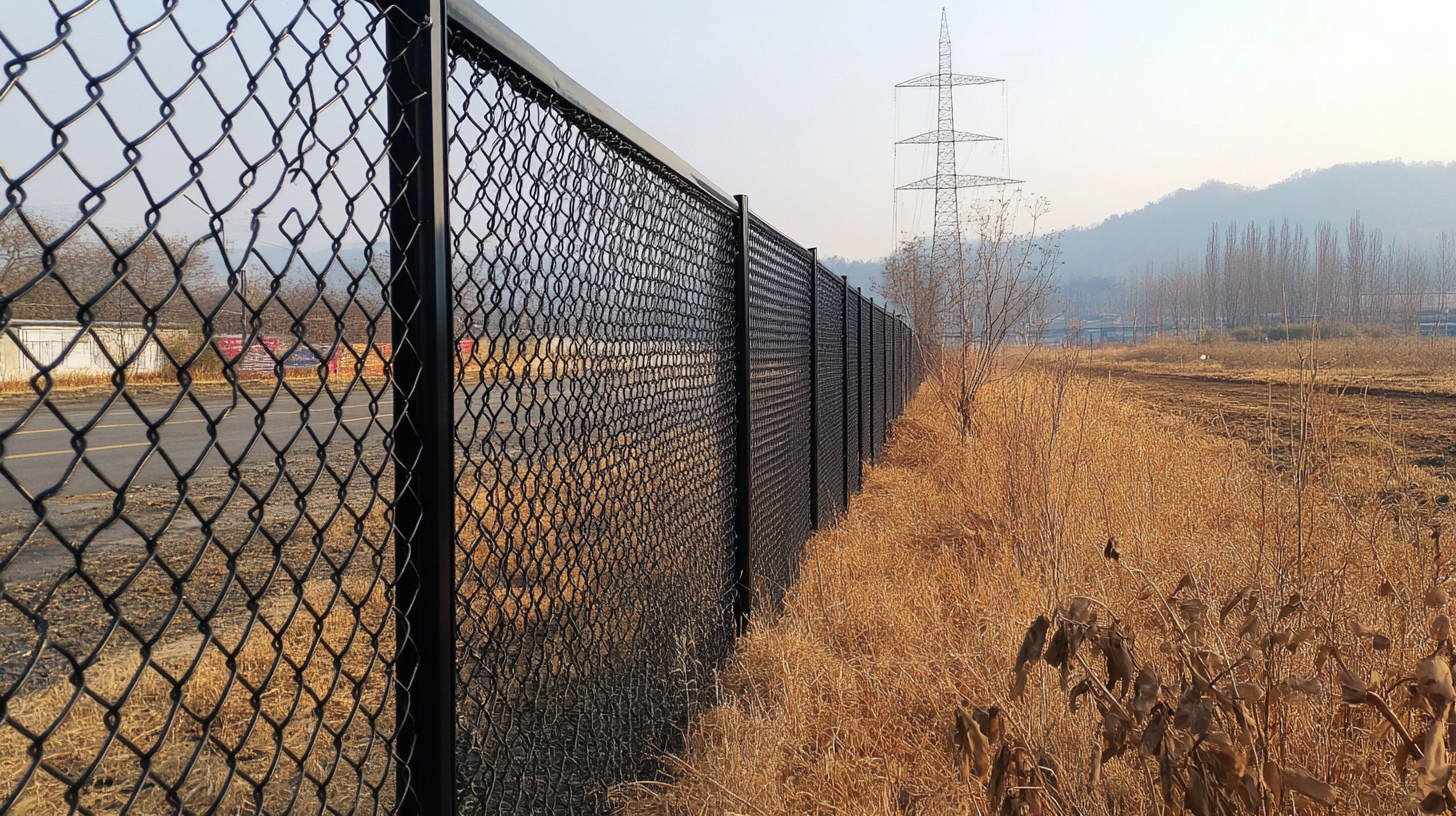Chinese Chain Link Mesh Fence Industry Thrives Amidst US China Tariff Impacts on Manufacturing
The Chain Link Mesh Fence industry in China is experiencing remarkable growth as it navigates the complexities of US-China tariff impacts on manufacturing. According to a recent market report, the global chain link fence market was valued at approximately $3.04 billion in 2022 and is projected to reach $4.02 billion by 2028, with a compound annual growth rate (CAGR) of over 5% during the forecast period. This growth is largely attributed to the increasing demand for enhanced security solutions across various sectors, including residential, commercial, and industrial applications. Furthermore, while tariffs imposed on Chinese goods by the United States have posed challenges, the resilience of Chinese manufacturers has been notable, leading to innovative production strategies and a focus on export diversification. As a result, the Chain Link Mesh Fence segment is not only counteracting tariff pressures but is also setting the stage for sustained expansion in both domestic and international markets.

The Resilience of China's Chain Link Mesh Fence Industry in a Tariff-Driven Landscape
In recent years, the Chinese chain link mesh fence industry has demonstrated remarkable resilience in the face of escalating tariffs and trade tensions with the United States. While many manufacturing sectors have struggled under the weight of increased costs and supply chain disruptions, this industry has leveraged its adaptability and innovation to remain competitive. By optimizing production processes and investing in advanced technologies, Chinese manufacturers have not only maintained their market share but also expanded their export capabilities.
Moreover, the strategic pivot towards domestic consumption has bolstered the industry. As more Chinese enterprises focus on meeting local demands, there is a growing emphasis on quality and customization. This shift has allowed manufacturers to create diverse products that cater to varying customer needs, setting them apart in a tariff-driven landscape. The combination of strong local demand and proactive adaptation has positioned China's chain link mesh fence industry for sustained growth, proving that resilience can turn challenges into opportunities.
Impact of US-China Tariffs on Competitive Pricing in the Mesh Fence Market
The ongoing US-China trade tensions have significantly altered the landscape of competitive pricing in the mesh fence market. With substantial tariffs imposed on Chinese imports, American manufacturers are faced with higher costs for materials and production. This has led to a reevaluation of pricing strategies as businesses strive to maintain their market share while navigating the economic challenges of increased expenses. As manufacturers absorb these tariffs, the price of domestically produced chain link mesh fences is also influenced, potentially creating a ripple effect across pricing structures in the industry.
In contrast, the Chinese chain link mesh fence industry has found new opportunities amidst these tariffs. With decreased competition from American manufacturers struggling with cost pressures, Chinese exporters have the chance to enhance their market positioning. They can leverage their established production capabilities and lower operating costs to offer competitive pricing, ultimately thriving despite the tariff impacts. This dynamic has prompted many customers to seek out Chinese products as a more affordable alternative, reshaping market strategies on both sides. As such, the interplay between tariffs and pricing will continue to shape the mesh fence sector in the coming years.

Exploring Growth Rates: Chinese Manufacturing vs. Tariff Challenges
The Chinese chain link mesh fence industry has experienced significant growth despite the challenges posed by tariffs imposed by the United States. As the tariffs aimed to protect local manufacturing, many American companies sought alternatives to reduce costs, inadvertently propelling demand for Chinese-made products. This shift has allowed Chinese manufacturers to increase their production capacities and innovate their offerings, ensuring that they remain competitive in a changing international landscape.
Analyzing the growth rates, it becomes clear that the Chinese manufacturing sector has adapted remarkably well to these external pressures. Instead of succumbing to the tariff challenges, manufacturers have found ways to enhance efficiency and improve product quality. By investing in technology and streamlining operations, they have been able to offset some of the impacts of tariffs and continue expanding their market share. The resilience displayed by the industry reflects not only in sales figures but also in its ability to forge new partnerships and explore untapped markets, highlighting the dynamic nature of global manufacturing amidst geopolitical tensions.

Strategic Innovations in Chinese Chain Link Fence Production Amid Trade Disruptions
The Chinese chain link mesh fence industry has demonstrated remarkable resilience in the face of ongoing tariffs and trade disruptions resulting from US-China relations. In response to these challenges, manufacturers are adopting strategic innovations to streamline production processes and enhance product offerings. Companies are investing in advanced technologies, such as automation and AI-driven manufacturing, which not only boosts efficiency but also improves the overall quality of the fencing products. This transition allows for a quicker turnaround time, enabling manufacturers to meet fluctuating market demands despite external pressures.
Moreover, the rise of sustainable practices within the industry has become a focal point for many Chinese manufacturers. By incorporating recycled materials and eco-friendly production methods, the industry is not only positioning itself competitively in the global market but also catering to the growing consumer preference for environmentally responsible products. As these manufacturers pivot towards greener practices, they are addressing both trade challenges and changing market trends, ensuring that their products remain appealing in an increasingly conscious consumer landscape. The convergence of innovative techniques and sustainability efforts is propelling the Chinese chain link mesh fence sector towards a robust future, proving that adaptation is key in turbulent times.
Chinese Chain Link Mesh Fence Industry Thrives Amidst US China Tariff Impacts on Manufacturing
| Year |
Industry Revenue (in million USD) |
Export Volume (in tons) |
Average Price per Ton (in USD) |
Innovation Index (Out of 10) |
| 2018 |
450 |
15000 |
300 |
7 |
| 2019 |
480 |
16000 |
300 |
8 |
| 2020 |
550 |
17000 |
323 |
9 |
| 2021 |
600 |
18000 |
333 |
9 |
| 2022 |
650 |
18500 |
351 |
10 |
Market Outlook: Future Trends for Chain Link Mesh Fence Exports from China
The chain link mesh fence industry in China is navigating a complex landscape shaped by geopolitical tensions and tariffs, particularly from the United States. According to market analysis from Research and Markets, the global chain link fence market is projected to reach $8.2 billion by 2026, with China expected to remain a pivotal supplier. Despite the challenges posed by US tariffs, which have increased costs for some manufacturers, Chinese companies are diversifying their export markets, exploring opportunities in Canada, Australia, and Southeast Asia.
The shift in export dynamics is underscored by a report from Statista, which indicates that China's exports of fencing products have shown resilience, with a growth rate of approximately 5% over the past year. Innovations in production processes and material efficiency are enabling manufacturers to maintain competitive pricing while adhering to international standards. As the industry evolves, a focus on quality and sustainable materials is expected to drive future trends, positioning Chinese chain link mesh fence exports favorably in an increasingly competitive global market.
Chinese Chain Link Mesh Fence Exports (2018-2023)
This chart illustrates the export trends of Chinese chain link mesh fences from 2018 to 2023. The data indicates a significant increase in exports, particularly in the years 2022 and 2023, reflecting the sector's resilience amidst tariff impacts and market demand.

Home
About Us
Products
Customize
Application
Support
Blog
Contact Us


